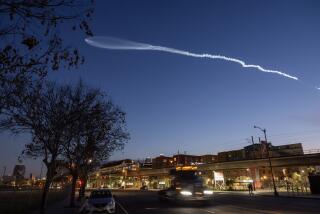Officials Upbeat Over Seal Beach Base Future
SEAL BEACH — Three days after the Seal Beach Naval Weapons Station was placed on the Pentagon’s “hit list,” city officials have decided against launching an immediate campaign to keep it open, saying such a move would be premature and unproductive.
Rather, City Council members and community leaders moved Monday to assure concerned residents that being placed on the Defense Base Closure and Realignment list does not necessarily mean that the base will close. It is even possible the weapons station might emerge from the process bigger and stronger, according to some officials.
“This is a closure-and-realignment list. I think we are looking at a realignment or expansion,” Councilman George Brown said. “I think that if we go and get everyone scared about a closure, we might do more harm than good.”
The approach is in marked contrast to the efforts of Irvine, Lake Forest and other cities, which have spent thousands of dollars to oppose the proposed closure of the El Toro Marine Corps Air Station.
The sprawling 5,000-acre base is used primarily for the loading and unloading of heavy ammunition and weapons from Navy vessels that dock in Anaheim Bay. A 1,000-acre national wildlife refuge is located on the east side of the weapons station.
“Of all the bases in Orange County, the Seal Beach weapons depot has the most easily defined military (use) in the post-Cold War world,” said Rep. Dana Rohrabacher (R-Huntington Beach). “You can park airplanes at a number of locations. You can’t load weapons onto ships in the same number of locations.”
Officials in both Washington and Orange County scrambled Monday to figure out exactly why the weapons station was added to the list late Friday. All told, the commission on Friday added three Air Force bases, 25 Navy installations, six Army bases and close to three dozen military depots to the growing list.
Gary Curran, Rohrabacher’s chief of staff, said the Military Base Closure and Realignment Commission might seek only to eliminate one of the many services provided by the Seal Beach facility.
Curran, citing information from a source at the commission, said the panel’s interest in the weapons station is limited to the “depot testing” of tactical missiles before they are loaded onto Navy ships. Such testing makes up less than 10% of the work done at the weapons station, he said.
The commission might be attempting to consolidate the number of military bases that conduct such tests, he said. Right now, eight military facilities and at least eight private contractors test the missiles, Curran said.
And even if depot testing is halted in Seal Beach, the station might receive additional duties as other bases close down. “It may--just may--make up for what is realigned away,” Curran added.
Because of these assessments, many officials are guardedly optimistic about the base’s future. “I am not ready to sound the alarm bells and mobilize the troops yet,” Rohrabacher said.
But few people can say for certain that the weapons station is safe. And if the commission does give serious thought to closing the base, Seal Beach’s tactics for saving the facility are likely to be different from those employed so far by the cities near El Toro.
Lake Forest allocated up to $10,000 and Irvine up to $2,000 this year to the Coalition for a Responsible Airport Solution, an organization made up of city officials, business leaders and residents fighting the proposed El Toro closure. As part of the effort, the coalition produced a 30-minute video for commission members that explained why El Toro should be spared.
Many Seal Beach officials conceded that the city could not afford to mount such a costly effort. The city is in the third year of a fiscal crisis that has forced significant cuts in spending and personnel. This year, the city faces at least a $1.7-million budget shortfall.
But what it might lack in financial power, Seal Beach might get from people power, some local activists said.
“I don’t think we are going to have a lot of money to spend, but I don’t think we will need it,” Brown said. He noted that residents of the Seal Beach Leisure World retirement community--located just across the street from the weapons station--would likely play a major role in any effort.
“The senior citizens have the time and the interest,” said Brown, himself a Leisure World resident. “I think there would be tremendous support for this kind of campaign from (seniors) and from the entire city.”
Others likely to oppose the closure are slow-growth advocates, environmentalists and surfers--all of whom have been active in opposing several developments proposed in the city in recent years.
“We want to save our wetlands,” Councilwoman Marilyn Bruce Hastings said. “We certainly don’t want someone to come in and build a marina and thousands of condos and townhouses.”
Seal Beach Naval Weapons Station * Size: 5,000 acres; includes 1,000-acre National Wildlife Refuge. * Duties: On- and offloads ammunition and weapons from Navy vessels. Also has a missile maintenance service center. * Employees: 950 civilian workers, 174 military personnel. * Myths: Many myths and rumors exist about the weapons station. A popular myth is that underground tunnels and secret underground buildings crisscross the base. The only tunnel in the area runs under Seal Beach Boulevard near Westminster Avenue. The tunnel was used in the 1960s and ‘70s to move portions of a rocket booster from Rockwell International across the street to a NASA facility without blocking traffic. Source: Seal Beach Naval Weapons Station * THE NEXT STEP: A new round of regional hearings on proposed base closures is set for next month in San Diego. B4
More to Read
Sign up for Essential California
The most important California stories and recommendations in your inbox every morning.
You may occasionally receive promotional content from the Los Angeles Times.











